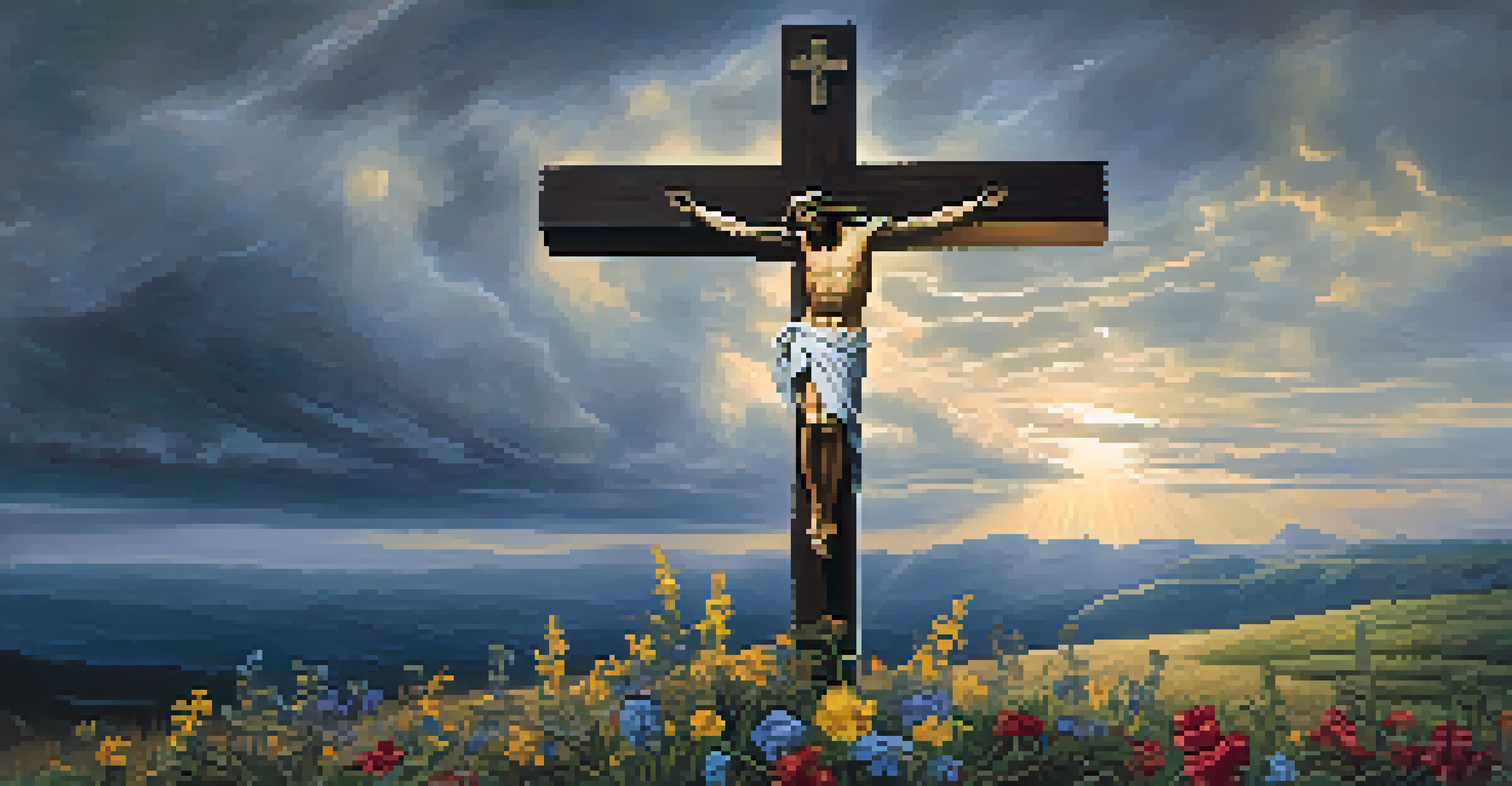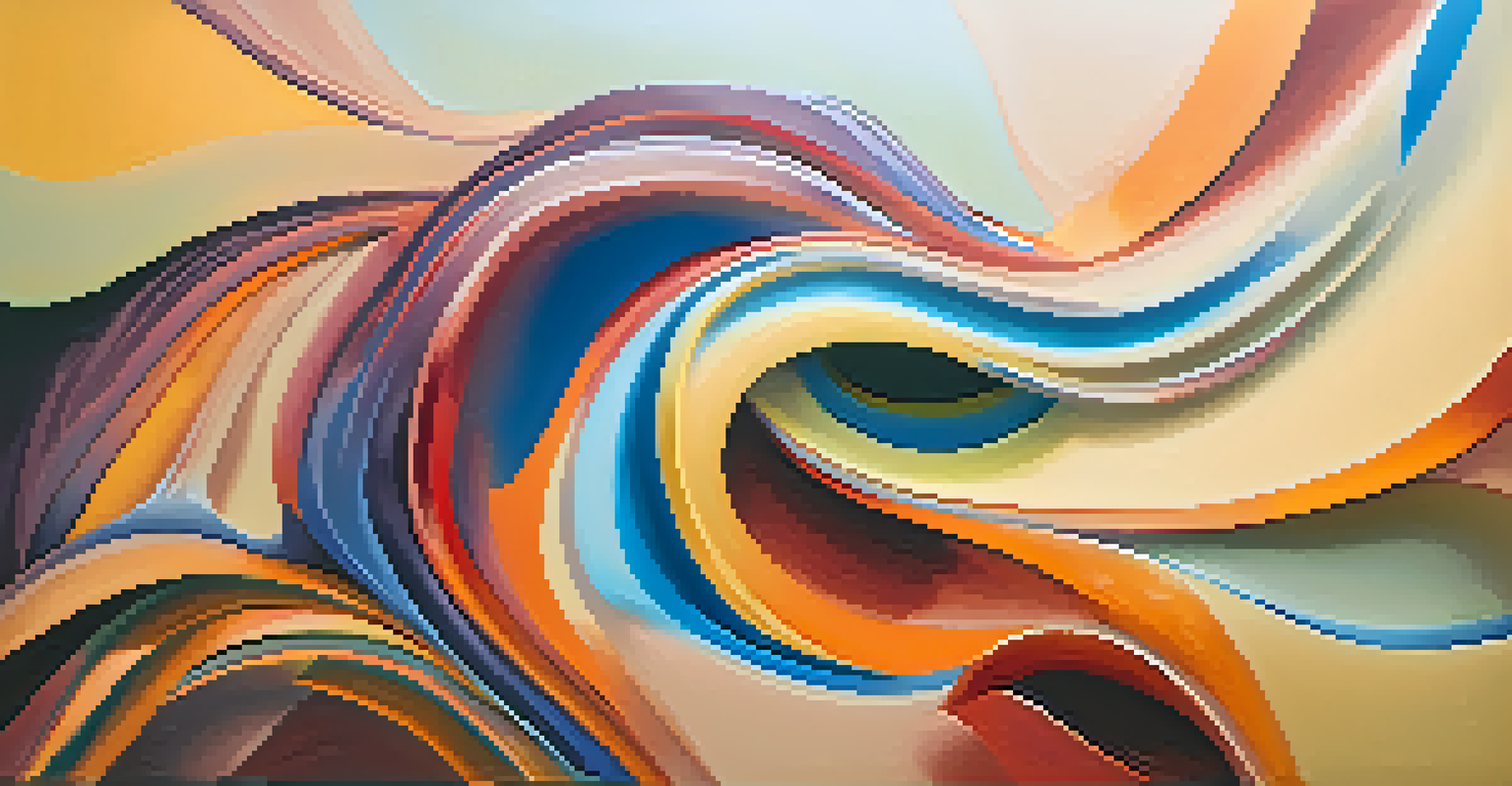The Sacred Body: Spirituality in Religious Art

Understanding the Sacred Body in Art
The concept of the 'sacred body' in religious art refers to the portrayal of the human form imbued with divine significance. Artists often depict figures such as Christ, the Virgin Mary, and saints, emphasizing their spiritual essence. This portrayal transcends mere physicality, inviting viewers to witness the intersection of the divine and the human experience.
Art is the most beautiful of all lies.
In various cultures, the sacred body is visualized through symbols and gestures that convey deep spiritual meanings. For example, the raised hands of a saint might symbolize prayer and connection to God. Such elements invite contemplation and reflection, allowing spectators to engage with the artwork on a more profound level.
The use of the sacred body in religious art serves as a bridge between the material world and the spiritual realm. It encourages viewers to reflect on their own spiritual journeys and the sacredness inherent in human existence. Through this connection, art becomes a powerful medium for expressing and exploring spirituality.
Historical Context of Sacred Body Representations
Throughout history, various art movements have shaped the representation of the sacred body. From the early Christian era to the Renaissance, artists adapted their techniques to convey spirituality through the human form. The evolution of styles reflects not only artistic preferences but also the changing perceptions of divinity and the sacred.

In the Middle Ages, for example, artists often depicted the sacred body in a stylized manner, using elongated proportions and flat perspectives. This approach emphasized the spiritual over the physical, guiding viewers toward a deeper understanding of faith. As we moved into the Renaissance, artists began to embrace realism, capturing the human form with greater anatomical accuracy while still conveying spiritual themes.
Sacred Body Connects Humanity and Divine
The portrayal of the sacred body in religious art serves as a bridge between the material and spiritual worlds, inviting viewers to reflect on their own spiritual journeys.
This historical journey illustrates how the sacred body has been a focal point for exploring spirituality across different eras. Each artistic period contributes unique insights into the relationship between the divine and humanity, enriching our appreciation of religious art.
Symbolism in Religious Art and the Sacred Body
Symbolism plays a crucial role in the representation of the sacred body within religious art. Artists often employ specific colors, gestures, and attributes to convey profound meanings. For instance, the use of gold can symbolize divine light, while a saint holding a specific symbol, like a lily, may represent purity.
The artist is the creator of beautiful things. To reveal art and conceal the artist is art's aim.
These symbols act as visual shorthand, helping viewers to decode the spiritual messages embedded within the artwork. For example, in many depictions of the Virgin Mary, her blue robes signify her heavenly status and purity, while the accompanying child, Jesus, embodies the sacred connection between humanity and divinity.
Understanding these symbols enhances our appreciation of the sacred body in art, allowing us to engage more deeply with the spiritual narratives presented. The interplay of symbolism and the sacred body creates a rich tapestry that invites ongoing exploration and contemplation.
The Role of Emotion in Religious Art
Emotion is a powerful element in religious art, particularly in how the sacred body is portrayed. Artists often capture intense feelings of compassion, love, and suffering, creating a connection with the viewer. This emotional resonance invites individuals to reflect on their own spiritual experiences in relation to the depicted figures.
For instance, the agony of Christ on the cross is depicted with such raw emotion that it evokes a sense of empathy and sorrow. This portrayal not only highlights the pain of sacrifice but also encourages viewers to contemplate the themes of redemption and forgiveness within their own lives.
Symbolism Enriches Spiritual Understanding
Symbolism in religious art, through colors and gestures, enhances appreciation of the sacred body by conveying profound spiritual meanings.
This emotional depth transforms the sacred body from a mere representation to a living, breathing conduit of spiritual experience. Through these emotional connections, viewers are encouraged to engage with their spirituality in a more meaningful way, enriching their understanding of religious art.
Cultural Influences on Sacred Body Representations
Cultural context significantly influences how the sacred body is represented in religious art. Different cultures have unique beliefs and practices that shape artistic expressions of spirituality. For example, Eastern and Western religious traditions often depict sacred figures in distinct ways that reflect their respective theological perspectives.
In Eastern art, for instance, the use of mandalas and intricate patterns often emphasizes the interconnectedness of all beings, while Western art might focus more on individual figures and narratives. This diversity enriches the portrayal of the sacred body, showcasing how various cultural lenses interpret spirituality.
By understanding these cultural influences, we can appreciate the broader tapestry of religious art. The sacred body becomes a universal symbol of spirituality, transcending cultural boundaries and inviting dialogue between different traditions.
Modern Interpretations of Sacred Bodies in Art
In contemporary art, the sacred body continues to evolve as artists explore new interpretations of spirituality. Many modern artists challenge traditional representations, using abstract forms or unconventional materials to express spiritual themes. This shift invites viewers to reconsider their understanding of the sacred body in the context of today's world.
For example, some artists may utilize performance art to embody the sacred body, inviting audiences to participate in a shared spiritual experience. This immersive approach fosters a direct connection between the viewer and the artwork, allowing for personal interpretations of spirituality.
Cultural Context Shapes Artistic Expression
Cultural influences significantly affect how the sacred body is represented in art, showcasing diverse interpretations of spirituality across different traditions.
These modern interpretations reflect the ongoing dialogue between art and spirituality, demonstrating that the sacred body remains a relevant and dynamic concept. As artists push boundaries, they encourage us to engage with spirituality in innovative ways, making the exploration of the sacred body a continuous journey.
The Impact of Religious Art on Personal Spirituality
Religious art, particularly through its representations of the sacred body, can have a profound impact on personal spirituality. Many individuals find that engaging with these artworks allows them to explore their own beliefs and feelings about the divine. The emotional and symbolic layers in religious art create a space for reflection and connection.
For instance, standing before a powerful painting of a saint can evoke feelings of inspiration and devotion, prompting viewers to consider their own spiritual journeys. This interaction between the viewer and the artwork can lead to personal transformations and deeper understandings of faith.

Ultimately, the sacred body in religious art serves not only as a representation of divinity but also as a catalyst for personal spiritual exploration. By engaging with these artworks, individuals can forge meaningful connections to their spirituality, enriching their lives in profound ways.